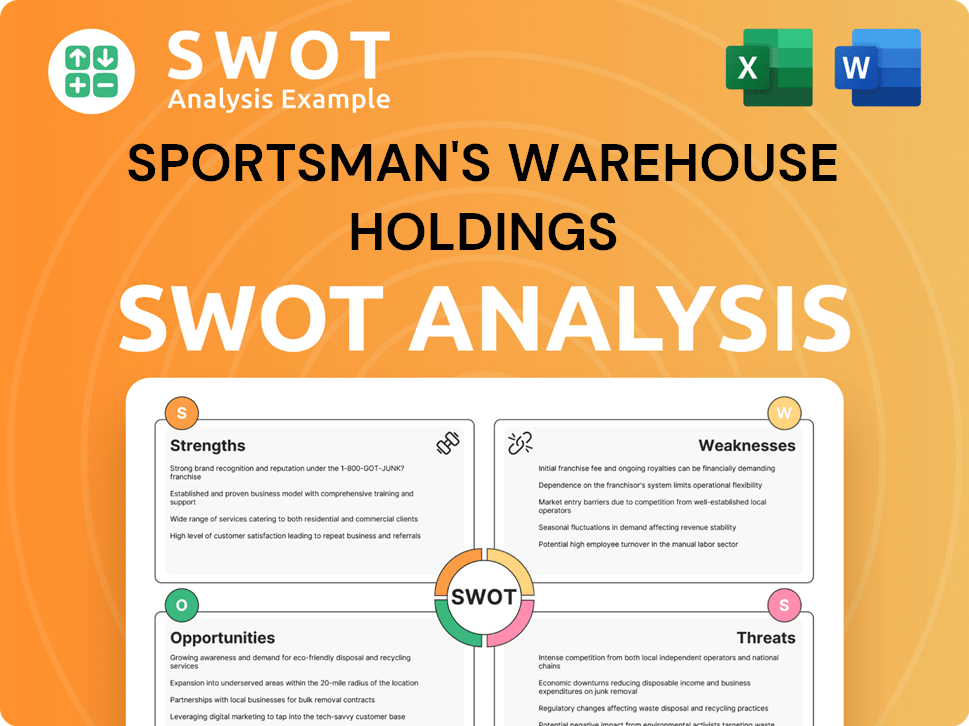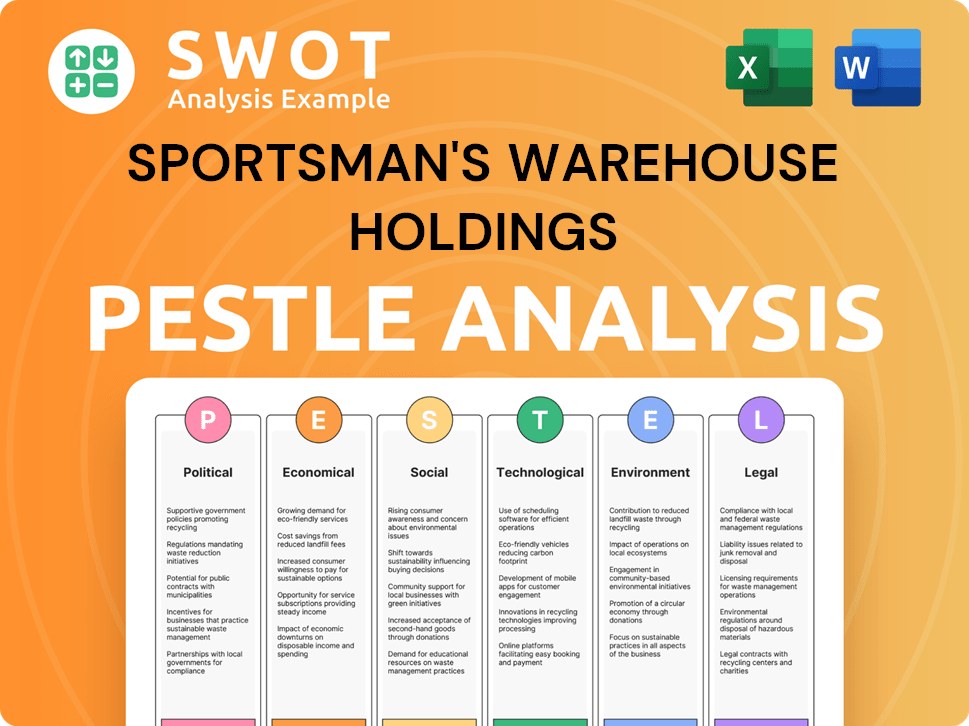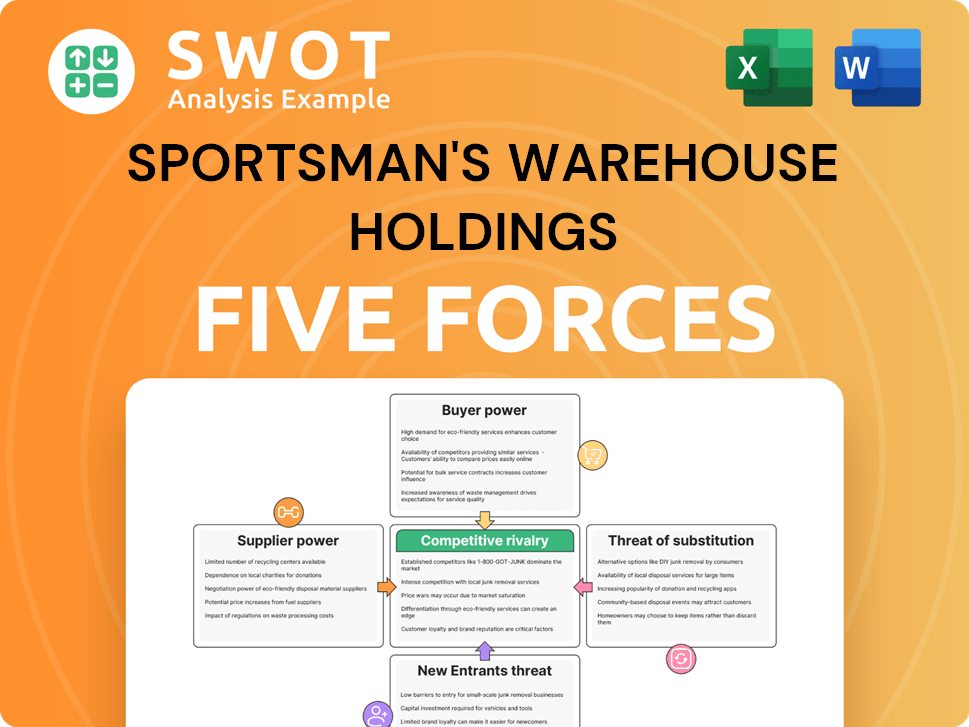Sportsman's Warehouse Holdings Bundle
How Did Sportsman's Warehouse Conquer the Outdoor Retail World?
From a single store in Utah to a nationwide presence, the Sportsman's Warehouse Holdings SWOT Analysis reveals a fascinating journey of growth and adaptation. Founded in 1986, this outdoor retailer has become a prominent name in the sporting goods industry, catering to enthusiasts across the country. Discover the key milestones and strategic decisions that shaped the Sportsman's Warehouse history.

This exploration of Sportsman's Warehouse Holdings delves into its founding, early expansion, and significant achievements. Understanding the Sportsman's Warehouse company timeline provides valuable insights into the challenges and triumphs that have shaped its current market position. Learn how this outdoor retailer has navigated economic fluctuations and consumer trends to remain a leading force in the sporting goods sector.
What is the Sportsman's Warehouse Holdings Founding Story?
The story of Sportsman's Warehouse Holdings began in 1986. Bill Hayes established the first store in Midvale, Utah. This marked the start of what would become a significant player in the outdoor retail sector.
The founding of Sportsman's Warehouse was driven by the idea of creating a comprehensive retail space. This space would cater to outdoor enthusiasts with a wide array of sporting goods. The initial focus was on serving a growing community of outdoor enthusiasts.
The company's early business model centered on offering a broad selection of quality, brand-name gear. It also emphasized knowledgeable staff to assist customers. The goal was to become a go-to destination for outdoor gear.
The original vision was to offer a wide range of products for various outdoor activities.
- The first store was located in Midvale, Utah.
- The company aimed to serve outdoor enthusiasts.
- The business model focused on a broad selection and knowledgeable staff.
- The company's initial focus was on hunting, shooting, camping, and fishing gear.
Sportsman's Warehouse Holdings SWOT Analysis
- Complete SWOT Breakdown
- Fully Customizable
- Editable in Excel & Word
- Professional Formatting
- Investor-Ready Format

What Drove the Early Growth of Sportsman's Warehouse Holdings?
The early growth of Sportsman's Warehouse Holdings, following its 1986 founding, was marked by significant expansion. The outdoor retailer focused on building a strong reputation by offering a wide selection of sporting goods and employing knowledgeable staff. This strategy fueled the opening of numerous stores, particularly across the Western United States during the late 1990s and early 2000s.
The company's store footprint saw considerable growth, reaching 75 stores across 20 states at one point. By fiscal year 2022, the company had expanded to 131 stores across 30 states. This expansion was a key part of the company's strategy to become a leading sporting goods provider.
The growth strategy involved both organic store openings and strategic acquisitions. In fiscal year 2020, the company acquired four stores from Dick's Sporting Goods, following an acquisition of 12 stores in fiscal year 2019. The initial goal was to grow store locations to between 190 and 210 by the end of fiscal year 2025.
Recent financial reports indicate a more cautious approach to expansion. No new stores were opened in fiscal year 2024. Only one new store is planned for fiscal year 2025, located in Surprise, Arizona. This shift reflects a change in strategy within the retail company history.
The company has invested significantly in its omni-channel presence, with e-commerce sales accounting for over 20% of total sales in fiscal year 2024. In Q1 2025, Sportsman's Warehouse reported a 2% increase in same-store sales. This growth was attributed to improved inventory management, local expertise, and a digital-first marketing approach.
Sportsman's Warehouse Holdings PESTLE Analysis
- Covers All 6 PESTLE Categories
- No Research Needed – Save Hours of Work
- Built by Experts, Trusted by Consultants
- Instant Download, Ready to Use
- 100% Editable, Fully Customizable

What are the key Milestones in Sportsman's Warehouse Holdings history?
The Sportsman's Warehouse history includes several key milestones that have shaped its trajectory as an outdoor retailer. These events highlight the company's evolution, from its initial public offering to navigating financial challenges and ultimately achieving renewed growth.
| Year | Milestone |
|---|---|
| 2004 | Went public on NASDAQ, aiming to raise capital for expansion. |
| 2006 | Filed for bankruptcy, leading to store closures but enabling restructuring. |
| 2009 | Emerging from bankruptcy, acquired by The Blackstone Group. |
| 2013 | Relisted on NASDAQ under the ticker 'SPWH' to support further growth. |
Innovations at Sportsman's Warehouse have centered on enhancing its omni-channel capabilities and operational efficiency. E-commerce sales have grown significantly, representing over 20% of total sales in fiscal year 2024, showcasing successful adaptation to digital trends.
The company has significantly invested in its online presence to meet the growing demand for online shopping. This strategic move has allowed Sportsman's Warehouse to reach a wider customer base.
Strategic investments in planogramming, merchandising, replenishment, and store scheduling tools have improved operational efficiency. These tools help optimize inventory management and enhance the in-store experience.
The company is focused on improving inventory accuracy to reduce costs and improve customer satisfaction. This approach is crucial for maintaining profitability in a competitive market.
Sportsman's Warehouse emphasizes its local expertise to differentiate itself and foster customer loyalty. This approach helps build strong relationships with customers.
The company is adopting a digital-first marketing approach to reach a wider audience and improve customer engagement. This strategy is essential for driving sales and traffic.
Integrating online and in-store experiences to provide customers with seamless shopping options. This strategy boosts customer satisfaction and sales.
Challenges for Sportsman's Warehouse have included intense competition within the fragmented outdoor retail market and economic downturns impacting discretionary spending. In fiscal year 2024, net sales decreased by 7.0% to $1,197.6 million, largely due to consumer inflationary pressures and recessionary concerns, and the company experienced a net loss of $(21.3) million in Q1 2025.
The outdoor retailer market is highly competitive, with numerous players vying for market share. This competition puts pressure on pricing and profitability.
Economic downturns significantly impact consumer spending on discretionary items, affecting sales. The company must adapt to changing economic conditions.
Supply chain disruptions can lead to inventory shortages and increased costs. Managing the supply chain efficiently is essential for maintaining operations.
Inflationary pressures reduce consumer purchasing power, leading to decreased sales. The company needs to manage costs and adjust pricing strategies.
The company has experienced net losses, which can impact investor confidence and financial stability. Addressing these losses is a priority.
Effective inventory management is crucial to minimize costs and maximize sales. The company focuses on optimizing inventory levels.
Sportsman's Warehouse Holdings Business Model Canvas
- Complete 9-Block Business Model Canvas
- Effortlessly Communicate Your Business Strategy
- Investor-Ready BMC Format
- 100% Editable and Customizable
- Clear and Structured Layout

What is the Timeline of Key Events for Sportsman's Warehouse Holdings?
The Sportsman's Warehouse Holdings journey began in 1986 with its founding in Midvale, Utah, by Bill Hayes. The company navigated significant milestones, including an initial public offering, bankruptcy, restructuring, and subsequent acquisitions. Sportsman's Warehouse history reflects a dynamic evolution, from its early years to its current position as an outdoor retailer.
| Year | Key Event |
|---|---|
| 1986 | Sportsman's Warehouse is founded by Bill Hayes in Midvale, Utah. |
| 2004 | The retail company goes public, listing its shares on NASDAQ. |
| 2006 | Sportsman's Warehouse files for bankruptcy and undergoes restructuring. |
| 2009 | The company emerges from bankruptcy and is acquired by The Blackstone Group. |
| 2013 | Sportsman's Warehouse goes public again, with shares listed on NASDAQ under 'SPWH.' |
| 2018 | The company opens its 100th store, a significant milestone in its expansion. |
| 2020 | Acquires four stores from Dick's Sporting Goods. |
| 2024 | Net sales are $1,197.6 million, with e-commerce sales exceeding 20% of total sales. |
| Q1 2025 | Achieves its first positive same-store sales growth in nearly four years, with a 2% increase; net sales increase by 2.0% to $249.1 million. |
| 2025 | Plans to open one new store in Surprise, Arizona. |
For fiscal year 2025, the company anticipates net sales to range from a 1.0% decline to a 3.5% increase. Adjusted EBITDA is projected to be between $33 million and $45 million. Capital expenditures are expected to be in the range of $20 million to $25 million, primarily for technology investments and store maintenance.
The company is focused on enhancing its omni-channel presence and leveraging local expertise. They aim to improve inventory precision, reduce overstock, and align store assortments with local demands. These efforts are designed to boost full-price sales and strengthen community connections, reflecting the evolution of Sportsman's Warehouse stores.
Sportsman's Warehouse aims to capitalize on demand in outdoor recreation through a disciplined turnaround strategy. Despite macroeconomic headwinds, the company expresses confidence in its plan to drive continued growth and financial improvement. The focus remains on serving outdoor enthusiasts with quality gear and exceptional service.
The company emphasizes building strong community connections and being the local choice for hunting and fishing solutions. This strategy reflects the impact of Sportsman's Warehouse on local communities and its commitment to serving its customers. This approach supports their growth strategy.
Sportsman's Warehouse Holdings Porter's Five Forces Analysis
- Covers All 5 Competitive Forces in Detail
- Structured for Consultants, Students, and Founders
- 100% Editable in Microsoft Word & Excel
- Instant Digital Download – Use Immediately
- Compatible with Mac & PC – Fully Unlocked

Related Blogs
- What is Competitive Landscape of Sportsman's Warehouse Holdings Company?
- What is Growth Strategy and Future Prospects of Sportsman's Warehouse Holdings Company?
- How Does Sportsman's Warehouse Holdings Company Work?
- What is Sales and Marketing Strategy of Sportsman's Warehouse Holdings Company?
- What is Brief History of Sportsman's Warehouse Holdings Company?
- Who Owns Sportsman's Warehouse Holdings Company?
- What is Customer Demographics and Target Market of Sportsman's Warehouse Holdings Company?
Disclaimer
All information, articles, and product details provided on this website are for general informational and educational purposes only. We do not claim any ownership over, nor do we intend to infringe upon, any trademarks, copyrights, logos, brand names, or other intellectual property mentioned or depicted on this site. Such intellectual property remains the property of its respective owners, and any references here are made solely for identification or informational purposes, without implying any affiliation, endorsement, or partnership.
We make no representations or warranties, express or implied, regarding the accuracy, completeness, or suitability of any content or products presented. Nothing on this website should be construed as legal, tax, investment, financial, medical, or other professional advice. In addition, no part of this site—including articles or product references—constitutes a solicitation, recommendation, endorsement, advertisement, or offer to buy or sell any securities, franchises, or other financial instruments, particularly in jurisdictions where such activity would be unlawful.
All content is of a general nature and may not address the specific circumstances of any individual or entity. It is not a substitute for professional advice or services. Any actions you take based on the information provided here are strictly at your own risk. You accept full responsibility for any decisions or outcomes arising from your use of this website and agree to release us from any liability in connection with your use of, or reliance upon, the content or products found herein.